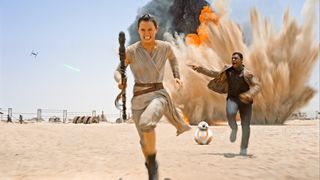
OLED TV maker LG Display is getting cosy with Disney, it seems, after an announcement of a three-year partnership between the OLED panel manufacturer and the massive entertainment conglomerate.
LG Display is now set to provide Disney’s StudioLAB department with “entry to the most recent advancements in OLED technology” and “new production tools”, in order to create new kinds of viewing experiences “tied to the Studio’s film releases”.
StudioLAB is essentially an incubator for storytelling techniques utilizing the most recent next-gen expertise – so it is sensible that OLED could be high on its list of collaboration applied sciences. However, what would it be used for?
OLED offers a host of viewing advantages, similar to its exceptional brightness control – given even pixel may be individually turned on and off – allowing for incredibly deep blacks and the excellent distinction between light and dark areas of a screen. Color recreation tends to be knockout, too. OLED TVs are already typically used as mastering displays by Hollywood studios; certainly, that is the primary selling level of the Panasonic HZ2000, which is touted by Hollywood colorist Stefan Sonnenfeld, who labored on Star Wars film The Force Awakens, among other blockbuster movies.
“The OLED suite of products gives us with the picture quality that we have to guarantee the perfect viewing expertise attainable for our filmmakers and our followers,” stated Eddie Drake, Head of Know-how at Marvel Studios. “Whether or not we’re evaluating contrast and shade accuracy or testing excessive viewing angles, OLED shows have demonstrated why their exceptional image high quality is in a league of its personal, and we look forward to seeing how OLED technology advances for years to come back.”
What’s new?

StudioLAB’s director of innovation partnerships, Matthew Deuel, writes that “we need to shortly develop and test new types of experiences, now more than ever”.
There’s an eternal race to create the next huge factor in cinematic viewing, even to the purpose of folly. Again in 2018, Cineworld unveiled a three-sided screen movie show expertise referred to as ScreenX, ostensibly to supply extra immersion during movies – a type of large-scale VR view the place you might see the motion on both facet of you too. Some inconsistent implementation, although (the facet screens would solely come ‘on’ at particular intervals throughout a movie) and a common sense of distraction within the periphery, means it hasn’t caught on.
When it comes to OLED, there’s plenty of innovation getting into the market too, similar to with LG’s rollable OLED, or the occasional clear OLED we hear about.
It is doubtless we can’t see the fruits of this collaboration for a while yet although, and it’s totally attainable the outcomes will find yourself as forgettable displays used for retail or theme parks (you understand after they reopen).
StudioLAB does work on a number of VR, AR and MR (virtual, augmented, and mixed actuality respectively) experiences, so it is possible we’ll see some overlap here.
We doubt we would see any content that could solely be considered by OLED TVs at dwelling (say, reasonably than on LCD or QLED), in case that is the place your thoughts went – if simply due to the splintering of the viewing audience that could create. If OLED continues to provide the benchmark for a way good Disney and Marvel movies ought to look on the best TVs, though, we’re not complaining.